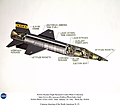English: Cutaway drawing of the North American X-15.
An unofficial motto of flight research in the 1940s and 1950s was "higher and faster." By the late 1950s the last frontier of that goal was hypersonic flight (Mach 5+) to the edge of space. It would require a huge leap in aeronautical technology, life support systems and flight planning. The North American X-15 rocket plane was built to meet that challenge. It was designed to fly at speeds up to Mach 6, and altitudes up to 250,000 ft. The aircraft went on to reach a maximum speed of Mach 6.7 and a maximum altitude of 354,200 ft. Looking at it another way, Mach 6 is about one mile per second, and flight above 264,000 ft. qualifies an Air Force pilot for astronaut wings.
The X-15 was a rocket-powered aircraft 50 ft long with a wingspan of 22 ft. It was a missile-shaped vehicle with an unusual wedge-shaped vertical tail, thin stubby wings, and unique side fairings that extended along the side of the fuselage. The X-15 weighed about 14,000 lb empty and approximately 34,000 lb at launch. The XLR-99 rocket engine, manufactured by Thiokol Chemical Corp., was pilot controlled and was capable of developing 57,000 lb of thrust. North American Aviation built three X-15 aircraft for the program.
The X-15 research aircraft was developed to provide in-flight information and data on aerodynamics, structures, flight controls, and the physiological aspects of high-speed, high-altitude flight. A follow-on program used the aircraft as a testbed to carry various scientific experiments beyond the Earth's atmosphere on a repeated basis.
For flight in the dense air of the usable atmosphere, the X-15 used conventional aerodynamic controls such as rudders on the vertical stabilizers to control yaw and movable horizontal stabilizers to control pitch when moving in synchronization or roll when moved differentially.
For flight in the thin air outside of the appreciable Earth's atmosphere, the X-15 used a reaction control system. Hydrogen peroxide thrust rockets located on the nose of the aircraft provided pitch and yaw control. Those on the wings controlled roll.
Because of the large fuel consumption, the X-15 was air launched from a B-52 aircraft at 45,000 ft and a speed of about 500 mph. Depending on the mission, the rocket engine provided thrust for the first 80 to 120 sec of flight. The remainder of the normal 10 to 11 min. flight was powerless and ended with a 200-mph glide landing.
Generally, one of two types of X-15 flight profiles was used; a high-altitude flight plan that called for the pilot to maintain a steep rate of climb, or a speed profile that called for the pilot to push over and maintain a level altitude.
The X-15 was flown over a period of nearly 10 years -- June 1959 to Oct. 1968 -- and set the world's unofficial speed and altitude records of 4,520 mph (Mach 6.7) and 354,200 ft in a program to investigate all aspects of piloted hypersonic flight. Information gained from the highly successful X-15 program contributed to the development of the Mercury, Gemini, and Apollo piloted spaceflight programs, and also the Space Shuttle program.
The X-15s made a total of 199 flights, and were manufactured by North American Aviation.
X-15-1, serial number 56-6670, is now located at the National Air and Space Museum, Washington DC. North American X-15A-2, serial number 56-6671, is at the United States Air Force Museum, Wright-Patterson AFB, Ohio. X-15-3, serial number 56-6672, crashed on 15 November 1967, resulting in the death of Maj. Michael J. Adams. Parts of the X-15-3 are on display at the Air Force Flight Test Center Museum at Edwards AFB, and the San Diego Aerospace Museum, San Diego, California.





